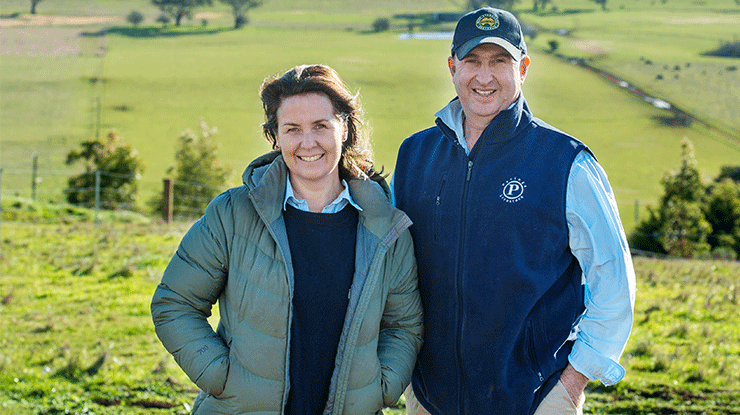 Image credit: The Weekly Times.
Image credit: The Weekly Times.
Victorian cattle producers Olivia and Tom Lawson, Paringa Livestock, have their sights set on a recipe to improve productivity and carbon neutrality.
They see genetics that drive higher reproductive rates and faster turn off, combined with grazing management that promotes carbon storage, as important to deliver carbon neutrality to southern beef producers.
For the past nine years, Paringa Livestock has bought industry-leading Australian and US genetics, which are tested for feed efficiency.
Tom Lawson says such genetics deliver emissions reductions via faster turn off (which means animals emit less methane in their lifetime) while lifting reproductive outcomes, such as weaning rates and weights. The Stabilizer® planned cross breeding and additive selection system that Tom and Olivia use can potentially produce 20% more beef per hectare and reduce carbon impact by 38%.
Tom and Olivia have also focused on carbon storage and reducing emissions for the past 10+ years, with a vegetation improvement program.
Expansion is constrained in an area with high productivity and land values, so they've had to think strategically about planting areas. They have fenced off remnant native trees and replanted around them, as well as fenced off waterways and replanted with local indigenous grasses, shrubs, and tree species with water reticulated to troughs.
These tree plantings contribute to stored carbon on Olivia and Tom's properties, as well as providing benefits such as shade and shelter for livestock, which supports productivity.
Digging deeper into soil carbon
Tom and Olivia wanted to dig deeper into exactly what makes a difference when calculating a beef enterprise's carbon account. So, Olivia joined more than 50 other producers in MLA's pilot carbon accounting workshops in 2020, which gave her a handle on where their enterprise stood.
"I've been looking into carbon accounting in more detail in the past 18 months and we're keen to support the industry goal of achieving carbon neutrality," she said.
Olivia and Tom both have agricultural science degrees and, more recently, Olivia has started a diploma in sustainable agriculture – providing a useful background as they head towards carbon neutrality.
They believe while carbon neutrality is achievable across their whole enterprise, it won't be easy.
Portions of their land are leased, which requires lessee and lessor agreement on financing any large investments in improvements like revegetation and permanent fencing.
Another challenge is accounting for the mixed vegetation species they have planted, which includes permanent stands of eucalypts, stringy barks, peppermint gums, yellow box, blackwoods and wattles.
"Mixed native species have increased our biodiversity, which we value" Olivia said.
The carbon accounting tool used in the MLA pilot workshop currently only enables inputs of single species, softwood, or hardwood. This means that tree carbon sequestration estimates in Olivia and Tom's account may be under or over estimated.
The primary driver of the pilot workshops was to undertake market research on the carbon accounting process to inform refinement and upgrades. Since Olivia participated, MLA and the research organisations involved have already invested in improving the carbon accounting tool used in the workshop. One of the major improvements was combining the sheep and beef tools, which eases the carbon accounting process for mixed production systems. Future improvements are also planned and will include input options for more regionally diverse, mixed- and single-tree species. This will enable a more accurate estimate of carbon stored in vegetation.
Practical steps
Tom and Olivia are also improving their carbon outcomes across these areas:
- Genetics
Increased production efficiency and weight for age are both key methods for reducing emissions intensity.
"Implementing a well-managed crossbreeding program is the simplest and lowest-cost way to increase efficiency and weight for age."
Paringa Livestock measures, monitors and benchmarks its genetic progress through Australia's BREEDPLAN and the global $Profit® database, which compares purebred and multi-breed genetics around the world.
For example, Angus Australia includes an estimated breeding value (EBV) for net feed efficiency in BREEDPLAN, which Tom and Olivia use to measure cattle for feed efficiency gains.
Angus Australia collected data on the net feed intake trait from thousands of progeny via the Angus Sire Benchmarking Program, which was supported by MLA and this information is now available to producers.
Tom and Olivia also seek out genetics from around the globe ranked highly for the $Profit° traits such as Feed to Gain and Intake.
- Soil management
Data from baseline soil carbon measurements are required for soil carbon management to be considered in a carbon account.
When Tom and Olivia first measured their agronomic soil carbon 10 years ago it was at 2% - two years later it was at 4%.
Olivia suspects their soil carbon may have doubled again due to actions such as:
- sowing new multi-species perennial pastures using zero tillage at depth
- applying a sugar-based liquid (mixed with glyphosate in the sprayer) when spraying pastures out to feed the soil biology
- using compost and mineral-based fertilisers instead of synthetic fertilisers.
"Livestock management is a key to growing soil carbon," Olivia said.
Cattle are managed in large mobs based on year groups in a rotational grazing system of high intensity intervals to maximise year-round ground cover.
She said they aim to continue to make soil carbon gains by reducing paddock size and increasing the intensity of rotations.
Conducting baseline measurements can be expensive, so MLA continues to invest in research aimed at reducing soil carbon measurement costs through remote sensing technology.
Lessons learned
Carbon accounting tips: tree plantings
The University of Melbourne has created a free spreadsheet for producers to enter their GHG emissions and calculate the emissions component of their carbon account. Download the carbon accounting calculator from: greenhouse.unimelb.edu.au/Tools.htm |






